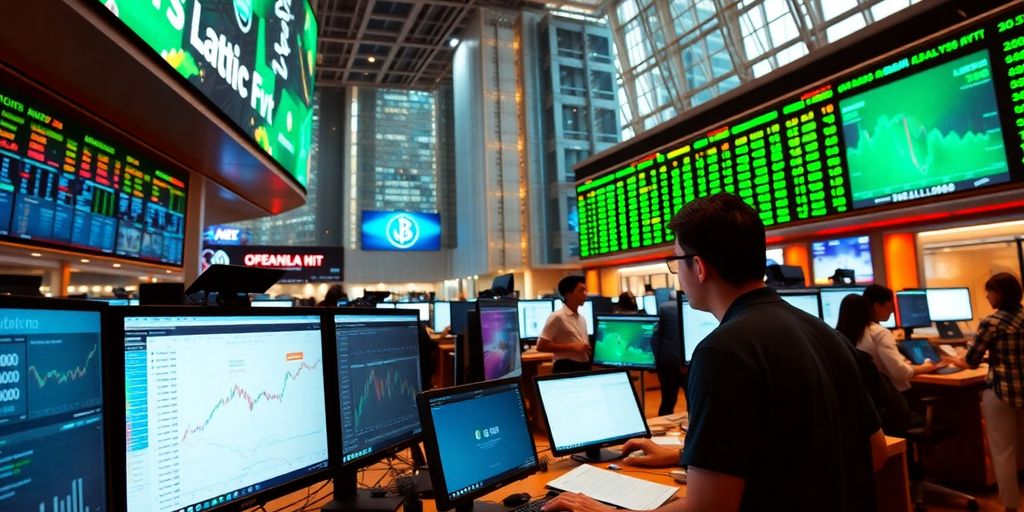In the fast-paced world of cryptocurrency trading, staying ahead of price changes is crucial for success, especially for arbitrage traders. These traders look for opportunities to buy low on one exchange and sell high on another, capitalizing on price differences. Real-time price alerts can give traders the edge they need to maximize their profits by providing timely notifications of these opportunities. This article explores the tools and strategies that can help arbitrage traders make the most of price alerts.
Key Takeaways
- Real-time price alerts are essential for arbitrage traders to seize opportunities quickly.
- Effective price alert systems should allow for customization and integration with various exchanges.
- Automated trading bots enhance the execution speed and accuracy of arbitrage trades.
- Understanding market conditions and diversifying strategies can improve trading outcomes.
- Using APIs can streamline the process of receiving alerts and executing trades.
Understanding Price Alerts for Arbitrage Traders

The Importance of Real-Time Data
In the world of arbitrage trading, having real-time data is crucial. I’ve learned that price discrepancies can appear and vanish in seconds. By using price alerts, I can stay updated on the latest market movements without constantly monitoring multiple exchanges. This allows me to act quickly when an opportunity arises.
How Price Alerts Enhance Trading Efficiency
Price alerts are like having a personal assistant for trading. They notify me when a cryptocurrency reaches a specific price point, which is essential for executing trades at the right moment. These alerts can be customized to trigger at certain thresholds, allowing traders to act quickly when an arbitrage opportunity presents itself. Here are some benefits I’ve experienced:
- Immediate notifications help me seize opportunities before they disappear.
- I can focus on other tasks while the alerts do the monitoring.
- Customizable settings allow me to tailor alerts to my trading strategy.
Common Tools for Setting Up Alerts
There are several tools available for setting up price alerts. Here’s a quick comparison of some popular options:
| Tool Name | Features | Cost |
|---|---|---|
| Crypto Alert | Custom alerts, mobile app | Free |
| CoinMarketCap | Price tracking, email alerts | Free |
| ArbitrageScanner | Cross-exchange alerts, automation | Subscription |
Each tool has its strengths, and I recommend trying a few to see which one fits your trading style best.
Price alerts are not just a convenience; they are a necessity for anyone serious about maximizing profits in arbitrage trading.
By understanding how to effectively use price alerts, I’ve been able to enhance my trading efficiency and capitalize on opportunities that I might have otherwise missed.
Key Features of Effective Price Alert Systems

Customizable Alert Criteria
In my experience, having customizable alert criteria is crucial for effective price alert systems. This feature allows me to set specific parameters, such as price thresholds or market scenarios, ensuring that I only receive notifications that matter to my trading strategy. Here are some key aspects:
- Price thresholds: Set alerts for specific price points.
- Market conditions: Customize alerts based on market trends.
- Currency pairs: Focus on the pairs that are relevant to my trading.
Integration with Multiple Exchanges
Another important feature is the ability to integrate with multiple exchanges. This capability enables me to monitor various platforms simultaneously, increasing my chances of spotting arbitrage opportunities. The benefits include:
- Real-time data: Access to live price feeds from different exchanges.
- Diverse trading options: Ability to trade across various platforms.
- Efficiency: Saves time by consolidating alerts in one place.
User-Friendly Interfaces
A user-friendly interface is essential for any trading tool. I prefer systems that are easy to navigate, allowing me to set up alerts quickly without a steep learning curve. Key points include:
- Intuitive design: Simple layout that makes navigation easy.
- Quick setup: Fast configuration of alerts without hassle.
- Mobile access: Ability to manage alerts on-the-go.
Effective price alert systems can significantly enhance my trading efficiency by automating the detection of opportunities. By leveraging these features, I can focus on executing trades rather than constantly monitoring the market.
Top Tools for Real-Time Price Alerts

In my experience as an arbitrage trader, having the right tools for real-time price alerts is crucial for maximizing profits. These tools help me stay ahead of the market by notifying me of price discrepancies across different exchanges. Here are some of the top tools I recommend:
Overview of Leading Platforms
- CoinCodex: Tracks over 37,000 cryptocurrencies and provides live prices and alerts.
- TradeSanta: Offers a user-friendly interface and supports multiple exchanges.
- 3Commas: Known for its advanced trading bots and automation features.
Comparing Features and Benefits
| Tool | Key Features | Pricing |
|---|---|---|
| CoinCodex | Real-time tracking, price alerts | Free with premium options |
| TradeSanta | Mobile apps, multiple bot types | Starting at $25/month |
| 3Commas | API integration, portfolio management | Various plans available |
User Testimonials and Experiences
Many users have shared positive experiences with these tools. For instance, one trader mentioned how TradeSanta’s intuitive dashboard made it easy to manage trades on the go. Another user highlighted the effectiveness of CoinCodex in providing timely alerts that led to profitable trades.
Using the right price alert tools has transformed my trading strategy, allowing me to seize opportunities I would have otherwise missed.
Leveraging API Integration for Price Alerts
Benefits of API Integration
Integrating APIs from various exchanges is a game-changer for traders like me. Using APIs allows me to access real-time price data directly within my trading platform. This means I can make quicker decisions and execute trades faster. Here are some key benefits:
- Real-time data access: I can retrieve live price updates and order book details.
- Automated trading: APIs enable me to set up automated trading strategies, which saves time and effort.
- Multi-exchange monitoring: I can track prices across different exchanges simultaneously, increasing my chances of finding arbitrage opportunities.
Setting Up API Connections
Setting up API connections might seem daunting, but it’s quite straightforward. Here’s how I do it:
- Choose the right exchanges: I select exchanges that offer reliable APIs.
- Create API keys: I generate API keys from the exchange’s settings to allow my trading platform to access data.
- Integrate with my trading system: I use the API documentation provided by the exchanges to connect and retrieve data.
Troubleshooting Common Issues
Even with the best setups, issues can arise. Here are some common problems I’ve faced and how I resolved them:
- Connection errors: I check my API keys and ensure they are correctly entered.
- Data discrepancies: I compare data from multiple sources to identify any inconsistencies.
- Rate limits: I monitor my API usage to avoid hitting the limits set by exchanges.
By leveraging API integration, I can enhance my trading efficiency and seize opportunities in real-time. This approach has significantly improved my ability to capitalize on price differences across exchanges.
Enhancing Arbitrage Strategies with Machine Learning

Predictive Models for Price Movements
In my experience, using machine learning can significantly improve how we predict price movements in arbitrage trading. By analyzing historical data, I can develop models that help identify potential price discrepancies across exchanges. This predictive capability allows me to act quickly when opportunities arise.
Adaptive Strategies in Real-Time
One of the most exciting aspects of machine learning is its ability to adapt. As market conditions change, my algorithms learn from new data, refining their strategies to maximize gains. This adaptability is crucial in the fast-paced world of crypto trading, where prices can shift rapidly.
Case Studies of Successful Implementations
I’ve seen firsthand how effective machine learning can be in arbitrage trading. Here are a few key takeaways from successful implementations:
- Increased Accuracy: Traders using machine learning models reported a higher success rate in identifying profitable trades.
- Faster Execution: Automated systems can execute trades much quicker than manual methods, capturing opportunities before they disappear.
- Reduced Risk: By continuously learning and adapting, these systems can help mitigate risks associated with market volatility.
Machine learning is not just a trend; it’s a game-changer for arbitrage traders. By leveraging advanced machine learning models, traders can identify arbitrage opportunities in real-time and execute them with precision.
Risk Management in Price Alert Systems
In my experience as an arbitrage trader, managing risks is crucial for success. Understanding the different types of risks can help me make informed decisions and protect my investments.
Identifying and Mitigating Liquidity Risks
Liquidity risk occurs when I can’t execute a trade at the desired price due to low market depth. Here are some strategies I use to manage this risk:
- Market Depth Analysis: I always check the market depth on exchanges to ensure there’s enough liquidity.
- Trade Size Management: I limit my trade sizes to avoid affecting the market price. Smaller trades are less likely to cause significant price changes.
- Choosing Reliable Exchanges: I prefer exchanges known for high liquidity to minimize slippage.
Managing Execution and Regulatory Risks
Execution risk can lead to missed opportunities or losses. Here’s how I tackle it:
- Use Reliable Exchanges: I stick to reputable exchanges with fast execution speeds.
- Automated Systems: I utilize automated trading systems to execute trades quickly and accurately, reducing the chance of errors.
- Stay Informed on Regulations: I keep up with legal changes that might affect my trading activities, ensuring compliance with all relevant laws.
Best Practices for Secure Trading
To enhance my trading security, I follow these best practices:
- Continuous Monitoring: I regularly monitor market conditions to identify potential risks.
- Diversifying Strategies: I implement a mix of arbitrage strategies to spread risk across different avenues.
- Performance Review: I review my trading performance frequently to identify areas for improvement.
By understanding and managing these risks, I can enhance my trading efficiency and protect my profits in the volatile world of arbitrage trading.
Maximizing Profits with Automated Trading Bots
Customization Options for Arbitrage Bots
When I first started using automated trading bots, I was amazed at how much I could customize them. Customization is key to making the most out of these tools. Here are some options I found particularly useful:
- Setting specific price thresholds for alerts.
- Choosing which exchanges to monitor for price differences.
- Adjusting trading volumes based on my risk tolerance.
Speed and Precision in Trade Execution
One of the biggest advantages of using trading bots is their speed. They can execute trades in milliseconds, which is crucial in the fast-paced world of crypto. I’ve seen bots react to price changes faster than I could even think about making a trade. This speed allows me to capitalize on opportunities that would otherwise slip away.
Popular Bots and Their Features
There are several trading bots that I’ve found to be particularly effective. Here’s a quick comparison of some of the top options:
| Bot Name | Key Features | Cost |
|---|---|---|
| ArbiTool | Real-time scanning, customizable settings | Subscription |
| HaasOnline | Advanced algorithms, fast execution | Subscription |
| 3Commas | User-friendly interface, multiple exchange support | Free/Paid |
In my experience, using an automated trading bot has significantly improved my trading efficiency and profitability. They help me stay ahead in a competitive market.
By leveraging these automated tools, I’ve been able to maximize my profits while minimizing the time and effort I spend on trading. The combination of speed, customization, and precision makes them invaluable for any serious arbitrage trader.
The Role of Market Data Providers in Arbitrage Trading
In my experience as an arbitrage trader, market data providers play a crucial role in maximizing profits. They offer real-time price feeds that help me stay updated on price discrepancies across different exchanges. Here are some key points to consider:
Real-Time Data Feeds and Their Importance
- Immediate Access: Having access to real-time data allows me to react quickly to market changes.
- Price Discrepancies: I can identify opportunities for arbitrage as soon as they arise, which is essential for success in this fast-paced environment.
- Examples of Providers: Some of the leading market data providers include Finage, CoinMarketCap, and CoinGecko.
Choosing the Right Market Data Provider
When selecting a market data provider, I consider the following factors:
- Reliability: The provider should have a proven track record of delivering accurate data.
- Coverage: It’s important that they cover multiple exchanges to give me a comprehensive view of the market.
- Integration: The ability to integrate their API into my trading platform is a must for seamless operation.
Integrating Data Feeds into Trading Systems
Integrating data feeds into my trading system has been a game-changer. Here’s how I do it:
- API Connections: I connect to the APIs of various exchanges to pull in real-time data.
- Automated Alerts: Setting up alerts based on specific price movements helps me act swiftly.
- Continuous Monitoring: I keep an eye on the data to ensure I don’t miss any potential opportunities.
By leveraging the right market data providers, I can enhance my trading strategies and increase my chances of success in arbitrage trading.
Innovative Approaches to Crypto Arbitrage
In my journey through the world of cryptocurrency trading, I have discovered that innovative strategies can significantly enhance arbitrage opportunities. Here are some of the most effective methods I’ve encountered:
Triangular Arbitrage
Triangular arbitrage is a fascinating approach where I trade between three different cryptocurrencies. For instance, I might exchange Bitcoin (BTC) for Ethereum (ETH), then ETH for Litecoin (LTC), and finally LTC back to BTC. This method allows me to profit from the price differences between each pair. However, success in this strategy relies heavily on executing trades quickly to capture fleeting price discrepancies.
Cross-Exchange Arbitrage
Cross-exchange arbitrage involves buying a cryptocurrency on one exchange and selling it on another where the price is higher. This strategy is straightforward but requires careful consideration of transaction costs, such as withdrawal and deposit fees. Minimizing these costs is essential for maximizing my gains. Additionally, the speed of transferring funds between exchanges is critical; delays can lead to missed opportunities.
Statistical Arbitrage
Statistical arbitrage uses mathematical models to identify price discrepancies between cryptocurrencies. By analyzing historical price data, I can predict future price movements. This method often involves:
- Quantitative Analysis: Identifying mispriced assets using statistical models.
- Machine Learning: Enhancing strategies by recognizing complex patterns and improving predictive accuracy.
By employing these innovative approaches, I have been able to maximize my gains in the dynamic world of crypto arbitrage. Continuous learning and adaptation are key to staying ahead in this fast-paced market.
In conclusion, exploring these innovative strategies has not only broadened my understanding of crypto arbitrage but also significantly improved my trading outcomes. Each method offers unique advantages, and I encourage fellow traders to experiment with them to find what works best for their trading style.
Practical Tips for Using Price Alerts Effectively
Monitoring Market Conditions
To make the most of price alerts, I find it essential to continuously monitor market conditions. This helps me spot arbitrage opportunities as they arise. Here are some strategies I use:
- Set up real-time alerts for price differences across exchanges. This allows me to react quickly when opportunities present themselves.
- Analyze market trends regularly. Keeping an eye on news and events can help me anticipate price movements that might create arbitrage chances.
- Utilize market data providers that offer real-time feeds. This ensures I stay updated on any price discrepancies.
Diversifying Arbitrage Strategies
I believe that diversifying my arbitrage strategies is crucial for maximizing profits. Here are a few approaches I consider:
- Triangular arbitrage: This involves trading between three different currencies to exploit price differences.
- Cross-exchange arbitrage: I look for price discrepancies between different exchanges to buy low and sell high.
- Statistical arbitrage: This method uses statistical models to identify and capitalize on price inefficiencies.
Continuous Optimization of Trading Systems
Finally, I focus on continuously optimizing my trading systems. This includes:
- Regularly reviewing my alert settings to ensure they align with current market conditions.
- Testing new strategies to see what works best in different market environments.
- Gathering feedback from my trading experiences to refine my approach.
By implementing these practical tips, I can enhance my trading efficiency and increase my chances of success in arbitrage trading. Staying proactive and adaptable is key to thriving in this fast-paced environment.
Conclusion
In conclusion, using real-time price alerts can greatly benefit arbitrage traders looking to maximize their profits across different exchanges. These tools not only save time but also help traders act quickly when opportunities arise. By automating the process of tracking price differences, traders can focus on making informed decisions rather than constantly monitoring the market. It’s essential to choose the right tools that fit your trading style and needs. With the right approach and the right tools, you can navigate the complexities of crypto arbitrage and enhance your trading success.
Frequently Asked Questions
What is a crypto arbitrage tracker?
A crypto arbitrage tracker is a tool that helps traders find chances to make money by spotting price differences for cryptocurrencies across different exchanges.
How does arbitrage work?
Arbitrage means buying a cryptocurrency at a lower price on one exchange and selling it at a higher price on another to earn a profit.
Why are real-time price alerts important?
Real-time price alerts let traders know immediately when there are price differences, helping them to act quickly and make profits.
What features should I look for in a price alert system?
Good price alert systems should let you customize alerts, connect with multiple exchanges, and have easy-to-use interfaces.
How can I use APIs for price alerts?
APIs can connect your trading platform to exchanges, allowing you to get real-time price data and automate your trading.
What role does machine learning play in arbitrage trading?
Machine learning helps traders predict price changes and adjust their strategies in real-time, making trading more effective.
What risks should I be aware of in arbitrage trading?
Traders should watch out for liquidity risks, execution risks, and regulatory risks that can affect their trades.
How can automated trading bots help with arbitrage?
Automated trading bots can execute trades faster than humans, helping traders take advantage of price differences quickly.





